- jdevbin – Includes an extended version of the Oracle JDeveloper 10g executable and OA Framework class libraries.
- jdevhome – Includes the OA Framework Toolbox Tutorial source and developer working area.
- jdevdoc – Contains documentation.
If you want to do some OAF Development in JDeveloper for the first time, you will need to do the following things.
1] Download JDeveloper Patch
Based on your instance release level, check out the version of JDeveloper to use using below link.
You can identify the OA Framework version in your instance by activating diagnostics and click the “About This Page” from any OAF page. Click the “Technology Components” tab. The OA Framework version in the top row of the table can then be matched to the JDeveloper Patch.
Download the JDeveloper Patch.
2] Extract the JDeveloper patch in a directory say D:DevSuiteHome_1jdev
The patch actually contains below three directories
3] Define an environment variable
Define an environment variable JDEV_USER_HOME for your local machine. This has to be set to jdevhomejdev directory. In above example it has to be D:DevSuiteHome_1jdevjdevhomejdev.
My Computer – Properties – Advanced tab – Environment Variables – New
Variable: JDEV_USER_HOME
Value: D:DevSuiteHome_1jdevjdevhomejdev
4] Extract Tutorial.zip
Extract D:DevSuiteHome_1jdev jdevbinTutorial.zip into D:DevSuiteHome_1jdev jdevhome.
It will create following directories
D:DevSuiteHome_1jdev jdevhomejdevmyhtml
D:DevSuiteHome_1jdev jdevhomejdevmyprojects
5] Get the DBC file
Obtain the FND database connection (.dbc) file from the system administrator who installed the OA Framework database where you want to do your development.
For the instance to use, you can get the .dbc file from $FND_SECURE and put it in <JDEV_USER_HOME>dbc_filessecure i.e. D:DevSuiteHome_1jdevjdevhomejdev dbc_filessecure
6] Creating a Desktop Shortcut to JDeveloper
To facilitate launching JDeveloper, create a desktop shortcut to jdevbinjdevbinjdevw.exe.
7] Configuring the Environment Encoding of JDeveloper
Confirm the environment encoding of your JDeveloper if it is appropriately set.
Go to Tools – Preferences – Environment – Encoding
If Encoding is not set to “UTF-8″, set it to “UTF-8″.
The initial setup is now complete!….Now you are ready to develop your first OAF page. For more information you can refer OAF Developer’s Guide.
Although Discoverer provides many functions for calculation in reports, sometime we require to use custom PL/SQL functions to meet additional Discoverer end user requirements (for example, to provide a complicated calculation). For this we first need to create the functions in database through Toad or other PL/SQL editors.
To access custom PL/SQL functions using Discoverer, you must register the functions in the EUL. When you have registered a custom PL/SQL function, it appears in the list of database functions in the “Edit Calculation dialog” and can be used in the same way as the standard Oracle functions.
Note: To register a PL/SQL function you must have EXECUTE privilege on that function.
You can register custom PL/SQL functions in two ways:
- Import automatically, by importing the functions (recommended)
- Manually
How to register custom PL/SQL functions automatically:
To register PL/SQL functions automatically you must import them in the following way:
1. Choose Tools | Register PL/SQL Functions to display the “PL/SQL Functions dialog: Functions tab”.
2. Click Import to display the “Import PL/SQL Functions dialog”. This dialog enables you to select the PL/SQL functions that you want to import.
3. Select the functions that you want to import. You can select more than one function at a time by holding down the Ctrl key and clicking another function.
4. Click OK.
Discoverer imports the selected functions and displays the function details in the “PL/SQL Functions dialog: Functions tab”. Information about the selected functions is imported automatically. In other words, you do not have to manually enter information or validate the information.
5. Click OK.
The PL/SQL function is now registered for use in Discoverer.
How to register custom PL/SQL functions manually:
To manually register a PL/SQL function for use in Discoverer:
1. Choose Tools | Register PL/SQL Functions to display the “PL/SQL Functions dialog: Functions tab”.
2. Click New and specify the function attributes.
3. Click Validate to check the validity and accuracy of the information you have entered.
4. If the function is invalid, correct the attributes and click Validate again.
5. (Optional) if the function accepts arguments:
a. Display the “PL/SQL Functions dialog: Arguments tab”.
b. On the Arguments tab, click New and specify the argument attributes.
6. Click OK when you have finished defining the function.
The custom PL/SQL function is now registered for use in Discoverer.
It is always recommended to register PL/SQL functions by importing automatically (especially if you have many functions to register), because it is easy to make mistakes when manually entering information about functions. When you import functions, all of the information about each function (for example, names, database links, return types, lists of arguments) is imported.
We can create list of values (LOV) for any parameter in discoverer reports through Item Classes. Here suppose in Discoverer Report, we have a parameter called Period Name. It has a small LOV icon in the right side.

When clicked on the LOV icon, the below window with all the Period Names will appear where you can choose one or many period names.
Now the question is how to do this. You just need to do the below steps to accomplish this task.
1] Create a custom folder named ‘Time Periods’ in a business area with the below query.
select distinct
period_name,
period_num,
period_year,
decode(period_num,1, 'January',
2, 'February',
3, 'March',
4, 'April',
5, 'May',
6, 'June',
7, 'July',
8, 'August',
9, 'September',
10, 'October',
11, 'November',
12, 'December', null) month_name
from gl_periods;
2] Select the business area in which you want to create an item class. Choose Insert > Item Class.
3] Select the LOV Item class attribute.
4] Select the above created folder (Time Periods) and choose the Period Name column.
5] Here you can select the various items of other folders that can use this item class. You can skip this stage and later you can manually assign this item class to other items.
6] Choose the defaults and click next.
7] Give a suitable name to the Item Class
8] Now go to the Item of the folder on which you created the Parameter (Period Name) and then go to Item Properties. Here you assign the item class that you have created just now.
9] If you already created the parameter in your workbook and your discover plus or desktop is open then close it and reopen. Then you can view the LOV attached to the parameter.
10] If you haven’t already created the parameter, then create the parameter and run the report. You can view the LOV attached to the parameter.
Complex folders contain items from one or more base folders. It is same like a view in database. It enables you to create a combined view of data from multiple folders.
A base folder can be any of the following types of folder:
- a simple folder, containing items based on columns in a single database table or view
- a custom folder, based on SQL statements
- a complex folder, containing items from one or more base folders
However you could produce the same result set using a database view instead of a complex folder. But using complex folders has few advantages over using database views.
- When we use complex folders, the sql queries are automatically optimized by Discoverer. If we use view, we cannot get that improved performance.
- We can create complex folders without database privileges, but for view creation we require that.
How to create complex folders?
1] Logon to Discoverer Administrator.
2] Select the business area in which you want to create a complex folder.
3] Choose Insert > Folder > New to create a new complex folder.
4] Click the new folder’s icon on the Data tab and choose Edit | Properties. We can give a more descriptive name, Description and Identifier Name for the new folder.
5] On the “Workarea: Data tab”, Drag an item from any folder in any open business area to the new folder. Or you can simply do copy and paste.
Tip: You might find it easier to drag items between folders if you have two Workareas open. To open a second Workarea, choose Window | New Window (Shift W).
Note: When you add an item to a complex folder, the folders that it comes from must be joined to the folder of at least one other item already in the complex folder. If this is not the case, Discoverer Administrator will display an error dialog.
Note: If you select items from two folders that are joined using more than one join, Discoverer displays the Choose Join dialog. Here you can select one or more joins and click OK.
Note: If you select an item from a simple folder that has a join that conflicts with existing items, Discoverer will display an error and you will not be allowed to add the item.
If you want to see all the joins, conditions and the workbooks that are based on your complex folder, go to Folder Properties | Dependents Tab.
What is complex folder reach through?
Complex folder reach through is a mechanism that enables Discoverer Plus and Discoverer Desktop users to add items to their worksheets in addition to those provided in a selected complex folder.
In Discoverer Administrator you can define one or more base folders within a complex folder as ’reach through enabled’. When a Discoverer Plus or Discoverer Desktop user selects an item from the complex folder, the associated reach through enabled base folders become available for selection in a worksheet.
About Discoverer:
Discoverer is the end user adhoc query, reporting and analysis tool, which provides quick development environment to develop Data Warehousing & Business intelligence reports.
What is business intelligence?
Business Intelligence is the ability to analyze data to answer business questions and predict futures.
Features and Benefits:
- Automated Summary Management – improving query performance in Discoverer Plus is now easier with this new feature.
- Oracle Applications support – This enables you to connect to Oracle Applications EULs as well as standard Discoverer EULs.
- Identifiers – all objects in a Business Area are now uniquely defined within each EUL by an Identifier.
- Change schema owner – you can now manually edit the schema Owner attribute (for a Folder) or leave it blank.
- Support for Oracle Materialized Views.
- Analytic Functions – perform complex mathematical analysis with this extended range of statistical functions.
How does it Works?
When a user creates or opens a worksheet, Discoverer:
- Converts the worksheet into the corresponding SQL statements (e.g. by converting folder names and item names to table names and column names respectively).
- Sends the SQL statements to the database.
- Displays the result set that is returned from the database.
Discoverer Components:
- Oracle Discoverer Administrator
- Oracle Discoverer Plus
- Oracle Discoverer Desktop Edition (Viewer)
Oracle Discoverer Administrator:
Discoverer Administrator is a tool to hide the complexity of the database from business users, so they can answer business questions quickly and accurately using Oracle Discoverer.
Discoverer Administrator’s wizard-style interfaces enable you to:
- Set up and maintain the End User Layer (EUL)
- Create Folders, Items and Item Classes
- Control access to information
- Create conditions and calculations for Discoverer end users to include in their worksheets
Oracle Discoverer Plus:
It is a web portal like Oracle Application front end through which you can log on with your oracle application username and password and create and run discoverer reports.
Oracle Discoverer Desktop Edition (Viewer):
It works same as Discoverer Plus, but it is a software that comes with Oracle BI Publisher setup. Here also you can create and run your discoverer reports.
End User Layer (EUL):
End User Layer is a Metadata repository for Business areas, folders and items on which Discoverer workbooks or reports based on. The EUL is a set of database tables that contain information (or ‘metadata’) about the other tables and views in the database.
Business Area:
A Business Area is a set of folders containing related information with a common business purpose.
Business Areas:
- Meet the specific data needs of the users
- Usually contain data from several different tables or views
- Have tables or views and their associated columns mapped to “folders” and “items” respectively
- Can contain many simple folders and complex folders
- May contain folders from one or more physical databases include conditions, joins, calculations, formatting, hierarchy structures, and other custom features
- May be accessible to one or many user IDs or roles; also, a user ID or role may be granted access to many business areas
- Let users access data, without having to understand the database structure
Folders:
The tables and views loaded into a Business Area are called as folders. There are 3 types of folders that you can create – Simple, Complex and Custom.
Items:
The columns of the folders are named as items.
Item Classes:
Item classes are like LOVs in Oracle Application. We can create item classes based on any columns of a table and we can join that item classes to any parameters of the discoverer reports.
Joins:
A Join relates two folders using common items.
Conditions:
Conditions filter worksheet data, enabling Discoverer end users to analyze only the data they are interested. Conditions are applied to the folders or items.
Calculations & Hierarchies:
A calculated item is an item that uses a formula to derive data for the item.
Hierarchies are default drill paths between item that you define in Discoverer Administrator. There are two types of Hierarchy in Discoverer Administration Edition:
- Item Hierarchies
- Date Hierarchies
Summaries & Summary Folders:
A summary improves query performance in Discoverer Plus or Discoverer Viewer by using pre-aggregated data created through Discoverer Administration Edition.
A Summary Folder is how Discoverer represents the underlying structure of a summary table or MV. Each Summary Folder has one or more Items (i.e. columns from a summary table or MV).
ASM:
Automated Summary Management – It delivers fast performing queries while greatly reducing the amount of time spent on administration. ASM analyzes your tables, uses query statistics (when available) and default values (the summary policy) to determine how summaries are created for you. ASM is able to automatically create and maintain the best set of summaries based on this combination.
Latest Posts
- R12 – How to Handle NULL for :$FLEX$.VALUE_SET_NAME In Oracle ERPAugust 25, 2023 - 1:20 pm
- R12 – How to Delete Oracle AR TransactionsMarch 22, 2019 - 8:37 pm
- How to Define Custom Key Flexfield (KFF) in R12January 19, 2018 - 5:43 pm
- AutoLock Box Concepts In R12November 10, 2017 - 8:30 am
- R12 – java.sql.SQLException: Invalid column type in OAFSeptember 15, 2017 - 9:39 am






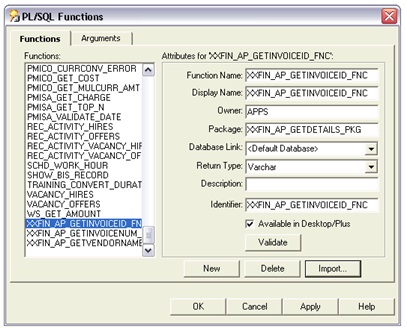

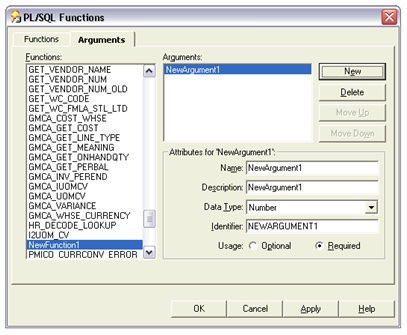

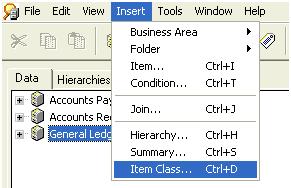



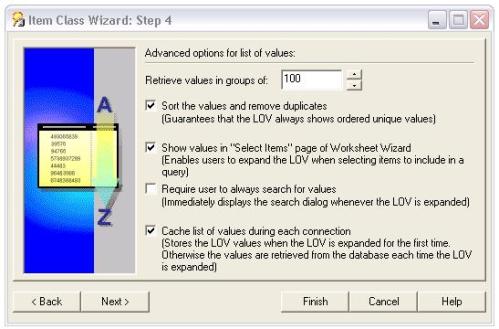
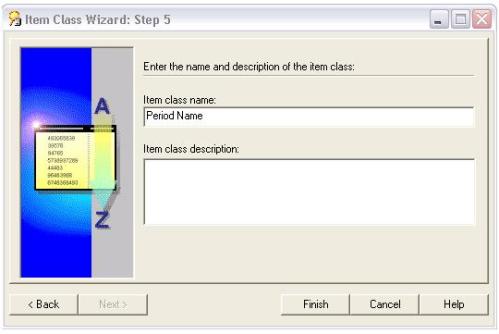
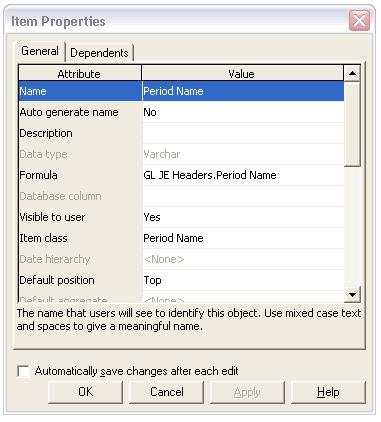
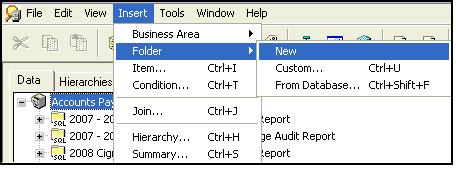
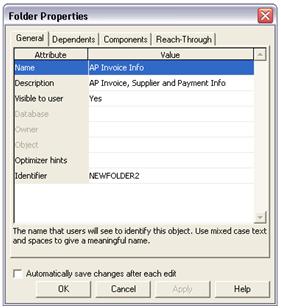

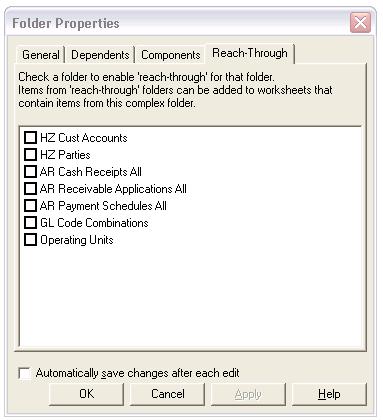
Recent Comments